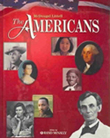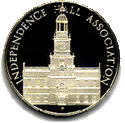American History Iby Matthew Caggia
- Unit 1A: Colonization & the 13 Colonies
- Unit 1B: Coming of the Revolution
- Unit 2A: Confederation & Compromise
- Unit 2B: The New Nation
- Unit 3: Sectionalism & Nationalism
- Unit 4: Reshaping the Nation
- Unit 5: Coming of the Civil War
- Unit 6: The Civil War
- Unit 7: Reconstruction
- Textbook
Unit 4: Reshaping the Nation
Chapters 8&9
As James Monroe leaves office so does the legacy of the founding fathers; he is the last founding father to serve as president. And with him goes the notion of the president as caretaker of the nation. The first five presidents saw themselves as defenders of an ideal. Next we will see how politics and sectionalism take center stage and in shaping the nation. The growth and expansion of the country comes with new problems and questions for society, including the role of women, changes in the production and industry, and what will create the biggest problem of all, slavery.
Study Tools
Slideshows
The slideshows are best if viewed full screen.
Reshaping the Nation
Use these guided notes while viewing the presentation.
Manifest Destiny
Use these guided notes while viewing the presentation.
Texas
Online Textbook Resources
 |
"The Americans" TextbookThese pages contain the links to the online content for student practice. It includes Chapter Overviews, Web Activities, Self-Check Quizzes, ePuzzles and Games, Vocabulary Flashcards, Charts in Motion (to accompany diagrams in the textbook), and Interactive Graphic Organizers.
|
|
USHistory.org Free Online TextbookEach link is to the beginning of a chapter. There are several sections within each chapter; I would like to link to each section, however it becomes too cumbersome for the webpage. Instead, click "Next" on each page to get to the next section of the online textbook. |  |
|
Vocabulary
Link to Quizlet! Vocabulary is the key to understanding any subject. Once you can break down the barrier of language the ideas and concepts are wide open. Here you can find the vocabulary for the unit to practice by using online flash cards and by practicing online generated vocabulary quizzes.
- Unit 4 Vocabulary Quiz on Quizlet
Practice your vocabulary for Unit 4 by trying this quiz of the unit's vocabulary.
When you get to the Quizlet Quiz page, you can adjust what type of quiz to take by using the check boxes on the right.
Videos!
The Second Great Awakening
A student-made documentary about the Second Great Awakening. Pretty well researched and exactly what we need to get some information about these reformers and movements. Use the Guided Notes as you watch to get the main points of each segment. Answer the questions in the margin to summarize your learning.
William Lloyd Garrison
Another student-made documentary. This, about William Lloyd Garrison, is included in the Slideshow "Reshaping the Nation" above. A nice summary of the life and activism of Garrison and his importance in the abolition movement.
Frederick Douglass
From biography.com, this brief documentary details the life and importance of Frederick Douglass in the abolition movement.
The Presidents: Martin Van Buren and William Henry Harrison
Watch the video and answer these multiple choice questions.
The Presidents: John Tyler
Watch the video and answer these multiple choice questions.
The Presidents: James K. Polk
Watch the video and answer these multiple choice questions.
Crash Course American History #12: The Market Revolution
From the publisher
John Green teaches you about the Market Revolution. In the first half of the 19th century, the way people lived and worked in the United States changed drastically. At play was the classic (if anything in a 30 year old nation can be called classic) American struggle between the Jeffersonian ideal of individuals sustaining themselves on small farms vs. the Hamiltonian vision of an economy based on manufacturing and trade. I'll give you one guess who won. Too late! It was Hamilton, which is why if you live in the United States, you probably live in a city, and are unlikely to be a farmer. Please resist the urge to comment about this if you live in the country and/or are a farmer. Your anecdotal experience doesn't change the fact that most people live in cities. In the early 19th century, new technologies in transportation and communication helped remake the economic system of the country. Railroads and telegraphs changed the way people moved goods and information around. The long and short of it is, the Market Revolution meant that people now went somewhere to work rather than working at home. Often, that somewhere was a factory where they worked for an hourly wage rather than getting paid for the volume of goods they manufactured. This shift in the way people work has repercussions in our daily lives right down to today. Watch as John teaches you how the Market Revolution sowed the seeds of change in the way Americans thought about the roles of women, slavery, and labor rights.
Crash Course American History #13: Slavery
From the publisher
John Green teaches you about America's "peculiar institution," slavery. I wouldn't really call it peculiar. I'd lean more toward horrifying and depressing institution, but nobody asked me. John will talk about what life was like for a slave in the 19th century United States, and how slaves resisted oppression, to the degree that was possible. We'll hear about cotton plantations, violent punishment of slaves, day to day slave life, and slave rebellions. Nat Turner, Harriet Tubman, and Whipped Peter all make an appearance. Slavery as an institution is arguably the darkest part of America's history, and we're still dealing with its aftermath 150 years after it ended.
Crash Course American History #15: 19th Century Reforms
From the publisher
John Green teaches you about various reform movements in the 19th century United States. From Utopian societies to the Second Great Awakening to the Abolition movement, American society was undergoing great changes in the first half of the 19th century. Attempts at idealized societies popped up (and universally failed) at Utopia, OH, New Harmony, IN, Modern Times, NY, and many other places around the country. These utopians had a problem with mainstream society, and their answer was to withdraw into their own little worlds. Others didn't like the society they saw, and decided to try to change it. Relatively new protestant denominations like the Methodists and Baptists reached out to "the unchurched" during the Second Great Awakening, and membership in evangelical sects of Christianity rose quickly. At the same time, Abolitionist societies were trying to free the slaves. Americans of the 19th century had looked at the world they were living in, and decided to change it.
Crash Course American History #16: Women in the 19th Century
From the publisher
John Green finally gets around to talking about some women's history. In the 19th Century, the United States was changing rapidly, as we noted in the recent Market Revolution and Reform Movements episodes. Things were also in a state of flux for women. The reform movements, which were in large part driven by women, gave these self-same women the idea that they could work on their own behalf, and radically improve the state of their own lives. So, while these women were working on prison reform, education reform, and abolition, they also started talking about equal rights, universal suffrage, temperance, and fair pay. Women like Susan B. Anthony, Carry Nation, Elizabeth Cady Stanton, the GrimkÚs, and Lucretia Mott strove tirelessly to improve the lot of American women, and it worked, eventually. John will teach you about the Christian Temperance Union, the Seneca Falls Convention, the Declaration of Sentiments, and a whole bunch of other stuff that made life better for women.
Crash Course American History #17: War & Expansion
From the publisher
John Green teaches you about the Mexican-American War in the late 1840s, and the expansion of the United States into the western end of North America. In this episode of Crash Course, US territory finally reaches from the Atlantic coast to the Pacific Ocean. After Oregon was secured from the UK and the southwest was ceded by Mexico, that is. Famous Americans abound in this episode, including James K Polk (Young Hickory, Napoleon of the Stump), Martin Van Buren, Zachary Taylor, and Winfield Scott. You'll also learn about the California Gold Rush of 1848, and California's admission as a state, which necessitated the Compromise of 1850. Once more slavery is a crucial issue. Something is going to have to be done about slavery, I think.
History Channel's Mexican-American War
The following playlist was found online dividing the entire video to fit YouTube formatting. Watch the video and complete the video guide.